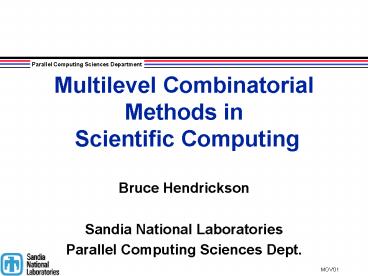Multilevel Combinatorial Methods in Scientific Computing PowerPoint PPT Presentation
1 / 23
Title: Multilevel Combinatorial Methods in Scientific Computing
1
Multilevel Combinatorial Methods in Scientific
Computing
- Bruce Hendrickson
- Sandia National Laboratories
- Parallel Computing Sciences Dept.
2
An Overdue Acknowledgement
- Parallel Computing Uses Graph Partitioning
- We owe a deep debt to circuit researchers
- KL/FM
- Spectral partitioning
- Hypergraph models
- Terminal propagation
3
In Return
- Weve given you
- Multilevel partitioning
- hMETIS
- Our applications are different from yours
- Underlying geometry
- More regular structure
- Bounded degree
- Partitioning time is more important
- Different algorithmic tradeoffs
4
Multilevel Discrete Algorithm
- Explicitly mimic traditional multigrid
- Construct series of smaller approximations
- Restriction
- Solve on smallest
- Coarse grid solve
- Propagate solution up the levels
- Prolongation
- Periodically perform local improvement
- Smoothing
5
Lots of Possible Variations
- More complex multilevel iterations
- E.g. V-cycle, W-cycle, etc.
- Not much evidence of value for discrete problems
- Key issue properties of coarse problems
- Local refinement multi-scale improvement
- Ill focus on graph algorithms
- Most relevant to VLSI problems
6
Not a New Idea
- Idea is very natural
- Reinvented repeatedly in different settings
- Focus of this workshop is on heuristics for hard
problems - Technique also good for poly-time problems
- E.g. Geometric point detection (Kirkpatrick83)
7
Planar Point Detection
- O(n log n) time to preprocess
- O(log n) time to answer query
8
Multilevel Graph Partitioning
- Invented Independently Several Times
- Cong/Smith93
- Bui/Jones93
- H/Leland93
- Related Work
- Garbers/Promel/Steger90, Hagen/Khang91,
Cheng/Wei91 - Kumar/Karypis95, etc, etc.
- Multigrid Metaphor H/Leland93 (Chaco)
- Popularized by Kumar/Karypis95 (METIS)
9
Multilevel Partitioning
- Construct Sequence of Smaller Graphs
- Partition Smallest
- Project Partition Through Intermediate Levels
- Periodically Refine
- Why does it work so well?
- Refinement on multiple scales (like multigrid)
- Key properties preserved on (weighted) coarse
graphs - (Weighted) partition sizes
- (Weighted) edge cuts
- Very fast
10
Coarse Problem Construction
- Find maximal matching
- Contract matching edges
- Sum vertex and edge weights
- Key Properties
- Preserves (weighted) partition sizes
- Preserves (weighted) edge cuts
- Preserves planarity
- Related to min-cut algorithm of Karger/Stein96
11
Extension ITerminal Propagation
- Dunlop/Kernighan85
- Skew partitioning to address constrained vertices
- Also useful for parallel computing
- Move few vertices when repartitioning
- Assign neighboring vertices to near processors
- H/Leland/Van Dreissche96
- Basic idea
- Vertex has gain-like preference to be in
particular partition
12
MultilevelTerminal Propagation
- How to include in multilevel algorithm?
- Simple idea
- When vertices get merged, sum preferences
- Simple, fast, effective
- Coarse problem precisely mimics original
13
Extension IIFinding Vertex Separators
- Useful for several partitioning applications
- E.g. sparse matrix reorderings
- One idea edge separator first, then min cover
- Problem multilevel power on wrong objective
- Better to reformulate multilevel method
- Find vertex separators directly
- H/Rothberg98
14
MultilevelVertex Separators
- Use same coarse constructor
- Except edge weights dont matter
- Change local refinement coarse solve
- Can mimic KL/FM
- Resulted in improved matrix reordering tool
- Techniques now standard
15
Extension IIIHypergraph Partitioning
- Coarse construction
- Contract pairs of vertices?
- Contract hyperedges?
- Traditional refinement methodology
- See talk tomorrow by George Karypis
16
Envelope Reduction
- Reorder rows/columns of symmetric matrix to keep
nonzeros near the diagonal
17
Graph Formulation
- Each row/column is a vertex
- Nonzero in (i,j) generates edge eij
- For row i of matrix (vertex i)
- Env(i) max(i-j such that eij in E)
- Envelope ? Env(i)
- Find vertex numbering to minimize envelope
- NP-Hard
18
Status
- Highest Quality algorithm is spectral ordering
- Sort entries of Fiedler vector (Barnard/Pothen/Sim
on95) - Eigenvector calculation is expensive
- Fast Sloan (Kumfert/Pothen97) good compromise
- Now multilevel methods are comparable
- (Boman/H96, Hu/Scott01)
- Related ordering problems with VLSI relevance
- Optimal Linear Arrangement
- Minimize ? i-j such that eij in E
19
Challenges for MultilevelEnvelope Minimization
- No precise coarse representation
- Cant express exact objective on coarse problem
- No incremental update for envelope metric
- I.e. no counterpart of Fiduccia/Mattheyses
- Our solution Use approximate metric
- 1-sum / minimum linear arrangement
- Allows for incremental update
- But still not an exact coarse problem
- VLSI applications?
20
Results
- Disappointing for envelope minimization
- We never surpassed best competitor
- Fast Sloan algorithm
- But Hu/Scott01 succeeded with similar ideas
- Better for linear arrangement, but
- Not competitive with Hur/Lillis99
- Multilevel algorithm with expensive refinement
21
Lessons Learned
- Good coarse model is the key
- Need to encode critical properties of full
problem - Progress on coarse instance must help real one
- Must allow for efficient refinement methodology
- Different objectives require different coarse
models - Quality/Runtime tradeoff varies w/ application
- Must understand needs of your problem domain
- For VLSI, quality is worth waiting for
- All aspects of multilevel algorithm are impacted
22
Conclusions
- Appropriate coarse representation is key
- Lots of existing ideas for construction coarse
problem - Matching contraction, independent sets,
fractional assignment, etc. - Multigrid metaphor provides important insight
- Were not yet fully exploiting multigrid
possibilities - Do we have something to offer algebraic
multigrid? - Need for CS recognition of multilevel paradigm
- Rich, general algorithmic framework, but not in
any textbook - Not the same as divide-and-conquer
23
Acknowledgements
- Shanghua Teng
- "Coarsening, Sampling and Smoothing Elements of
the Multilevel Method - Rob Leland
- Erik Boman
- Ed Rothberg
- Tammy Kolda
- Chuck Alpert
- DOE MICS Office

